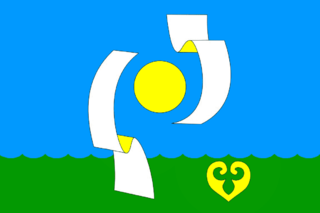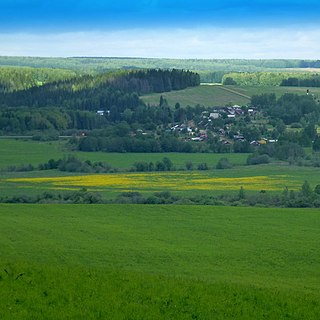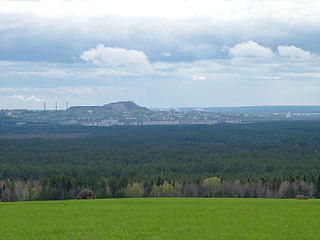
Kudymkar, is a town and the administrative center of Komi-Permyak Okrug of Perm Krai, Russia. Until 2005, it was the administrative center of Komi-Permyak Autonomous Okrug, a federal subject of Russia. It is located on the Inva River and on the left bank of its tributary the Kuva; 201 kilometers (125 mi) from Perm by road. Population: 28,967 (2010 Census).

Chusovoy is a town in Perm Krai, Russia, located at the confluence of the Usva and Vilva Rivers with the Chusovaya River, 140 kilometers (87 mi) east of Perm, the administrative center of the krai. Population: 46,735 (2010 Census); 51,615 (2002 Census); 57,874 (1989 Soviet census).

Alexandrovsk is a town in Perm Krai, Russia, located on the Lytva River, 185 kilometers (115 mi) northeast of Perm, the administrative center of the krai. Population: 14,495 (2010 Census); 16,231 (2002 Census); 20,073 (1989 Soviet census).

Gornozavodsk is a town and the administrative center of Gornozavodsky District in Perm Krai, Russia, located 192 kilometers (119 mi) northeast of Perm, the administrative center of the krai. Population: 12,057 (2010 Census); 13,061 (2002 Census); 14,858 (1989 Soviet census). It was previously known as Novopashiysky.

Nytva is a town and the administrative center of Nytvensky District in Perm Krai, Russia, located on the Nytva River near its confluence with the Kama, 70 kilometers (43 mi) west of Perm, the administrative center of the krai. Population: 19,041 (2010 Census); 20,660 (2002 Census); 21,861 (1989 Soviet census).

Okhansk is a town and the administrative center of Okhansky District in Perm Krai, Russia, located on the right bank of the Kama River, 119 kilometers (74 mi) southwest of Perm, the administrative center of the krai. Population: 7,250 (2010 Census); 7,994 (2002 Census); 8,414 (1989 Soviet census).

Osa is a town and the administrative center of Osinsky District in Perm Krai, Russia, located on the left bank of the Kama River near its confluence with the Tulva, 146 kilometers (91 mi) southwest of Perm, the administrative center of the krai. As of the 2010 Census, its population was 21,188.

Dobryanka is a town in Perm Krai, Russia, located on the bank of the Kama Reservoir, 61 kilometers (38 mi) north of Perm, the administrative center of the krai. Population: 33,686 (2010 Census); 36,436 (2002 Census); 35,317 (1989 Soviet census).

Kudymkarsky District is an administrative district (raion) of Komi-Permyak Okrug in Perm Krai, Russia; one of the thirty-three in the krai. As a municipal division, it is incorporated as Kudymkarsky Municipal District. It is located in the west of the krai. The area of the district is 4,741 square kilometers (1,831 sq mi). Its administrative center is the town of Kudymkar. Population: 25,808 (2010 Census); 29,528 (2002 Census); 35,392 (1989 Soviet census).

Beryozovsky District is an administrative district (raion) of Perm Krai, Russia; one of the thirty-three in the krai. Municipally, it is incorporated as Beryozovsky Municipal District. It is located in the southeast of the krai. The area of the district is 1,977 square kilometers (763 sq mi). Its administrative center is the rural locality of Beryozovka. Population: 17,042 (2010 Census); 18,516 (2002 Census); 20,242 (1989 Soviet census). The population of Beryozovka accounts for 40.5% of the district's total population.

Cherdynsky District is an administrative district (raion) of Perm Krai, Russia; one of the thirty-three in the krai. Municipally, it is incorporated as Cherdynsky Municipal District. It is located in the north and northeast of the krai and borders with the Komi Republic in the north, Krasnovishersky District in the east, Solikamsky District in the south, Kosinsky District in the southwest, and with Gaynsky District in the west. The area of the district is 20,872 square kilometers (8,059 sq mi). Its administrative center is the town of Cherdyn. Population: 24,568 (2010 Census); 35,152 (2002 Census); 40,688 (1989 Soviet census). The population of Cherdyn accounts for 20.0% of the district's total population.

Kishertsky District is an administrative district (raion) of Perm Krai, Russia; one of the thirty-three in the krai. Municipally, it is incorporated as Kishertsky Municipal District. It is located in the southeast of the krai. The area of the district is 1,400 square kilometers (540 sq mi). Its administrative center is the rural locality of Ust-Kishert. Population: 12,777 (2010 Census); 15,093 (2002 Census); 17,957 (1989 Soviet census). The population of Ust-Kishert accounts for 32.9% of the district's total population.

Kungursky District is an administrative district (raion) of Perm Krai, Russia; one of the thirty-three in the krai. Within the framework of municipal divisions, it is incorporated as Kungursky Municipal District. It is located in the southern central part of the krai and borders with the territories of the towns of krai significance of Chusovoy in the north and Lysva in the northeast, Beryozovsky, Suksunsky, and Kishertsky Districts in the east, Ordinsky and Uinsky Districts in the south, Bardymsky District in the southwest, Osinsky District in the west, and with Permsky District in the north. The area of the district is 4,416 square kilometers (1,705 sq mi). Its administrative center is the town of Kungur. Population: 42,450 (2010 Census); 46,332 (2002 Census); 47,949 (1989 Soviet census).

Nytvensky District is an administrative district (raion) of Perm Krai, Russia; one of the thirty-three in the krai. Municipally, it is incorporated as Nytvensky Municipal District. It is located in the southwestern central part of the krai. The area of the district is 1,656 square kilometers (639 sq mi). Its administrative center is the town of Nytva. Population: 43,812 (2010 Census); 47,779 (2002 Census); 50,338 (1989 Soviet census). The population of Nytva accounts for 43.5% of the district's total population.

Ochyorsky District is an administrative district (raion) of Perm Krai, Russia; one of the thirty-three in the krai. Municipally, it is incorporated as Ochyorsky Municipal District. It is located in the southwest of the krai. The area of the district is 1,330 square kilometers (510 sq mi). Its administrative center is the town of Ochyor. Population: 22,828 (2010 Census); 25,347 (2002 Census); 27,013 (1989 Soviet census). The population of Ochyor accounts for 62.4% of the district's total population.

Okhansky District is an administrative district (raion) of Perm Krai, Russia; one of the thirty-three in the krai. Municipally, it is incorporated as Okhansky Municipal District. It is located in the southwest of the krai. The area of the district is 1,516 square kilometers (585 sq mi). Its administrative center is the town of Okhansk. Population: 16,272 (2010 Census); 17,873 (2002 Census); 18,747 (1989 Soviet census). The population of Okhansk accounts for 44.6% of the district's total population.

Ordinsky District is an administrative district (raion) of Perm Krai, Russia; one of the thirty-three in the krai. Municipally, it is incorporated as Ordinsky Municipal District. It is located in the southeast of the krai, mostly in the valley of the Iren River. The area of the district is 1,418 square kilometers (547 sq mi). Its administrative center is the rural locality of Orda. As of the 2010 Census, the total population of the district was 15,605, with the population of Orda accounting for 34.4% of that number.

Perm District is an administrative district (raion), one of the thirty-three in Perm Krai, Russia. Population - 116,353 (2021)

Solikamsky District is an administrative district (raion), one of the thirty-three in Perm Krai, Russia. Within the framework of municipal divisions, it is incorporated as Solikamsky Municipal District. It is located in the northern central part of the krai. The area of the district is 5,421 square kilometers (2,093 sq mi). Its administrative center is the town of Solikamsk. Population: 17,165 (2010 Census); 18,333 (2002 Census); 19,450 (1989 Soviet census).

Suksunsky District is an administrative district (raion) of Perm Krai, Russia; one of the thirty-three in the krai. Municipally, it is incorporated as Suksunsky Municipal District. It is located in the southeast of the krai. The area of the district is 1,977 square kilometers (763 sq mi). Its administrative center is the urban locality of Suksun. Population: 20,099 (2010 Census); 21,925 (2002 Census); 23,654 (1989 Soviet census). The population of Suksun accounts for 39.9% of the district's total population.
































